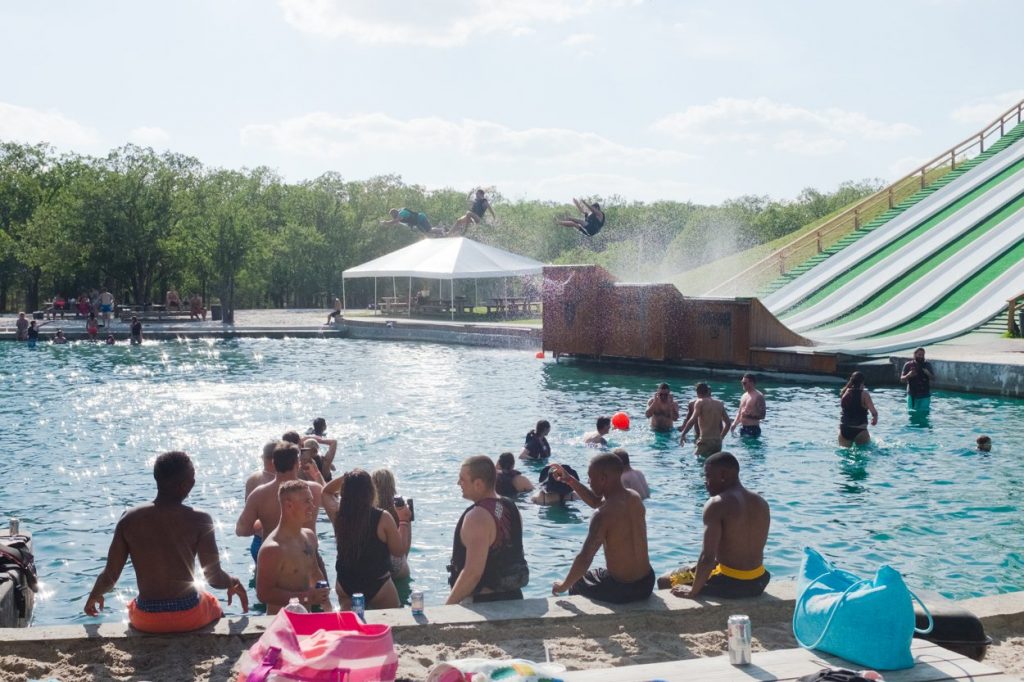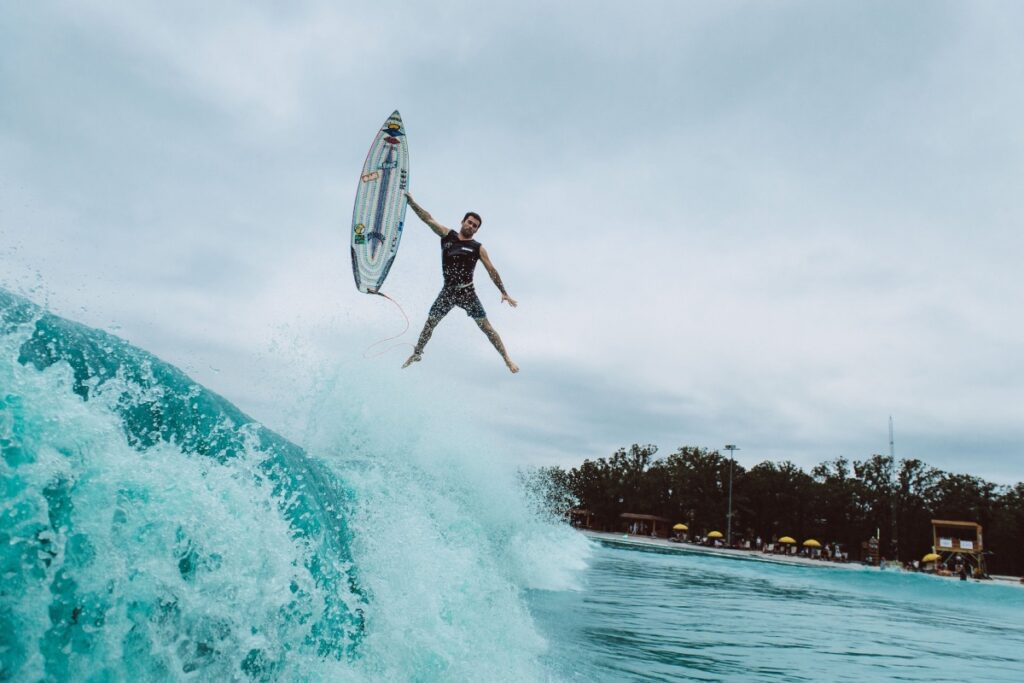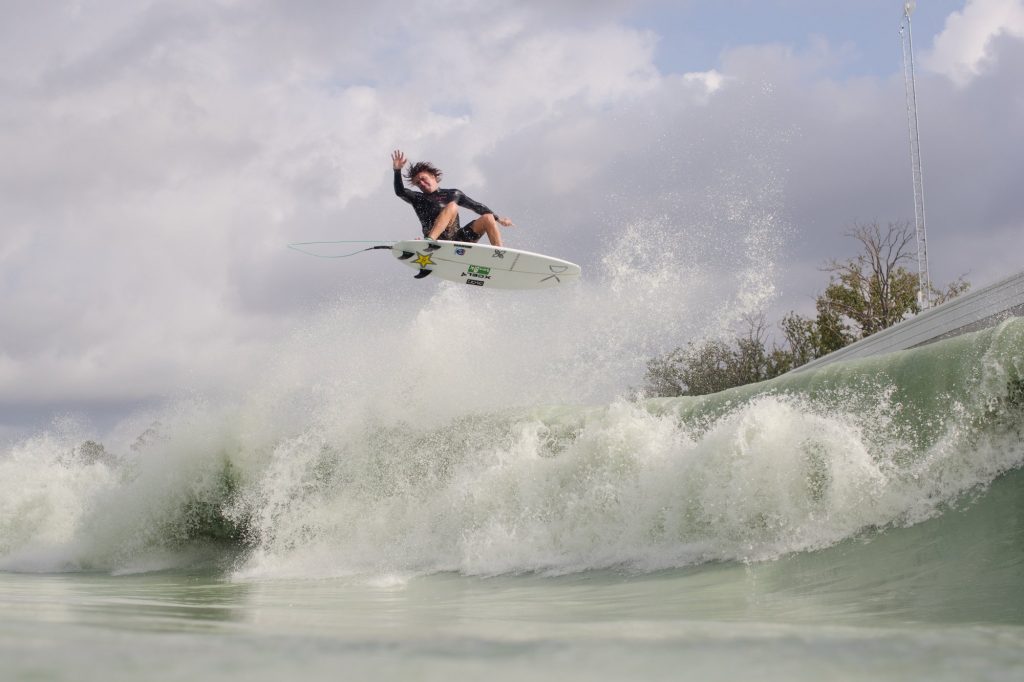How To Win Stab High Japan, Presented By Monster Energy
A statistical analysis of the 493 airs attempted in previous chlorinated editions.
Find everything you need to know about Stab High Japan, presented by Monster Energy here.
Event is live on June 22-23 local time (JST), or June 21-22 in the Americas.
“No kook has ever won at Bells Waco.”
Shane Dorian didn’t actually say that, but considering the pedigree of all three surfers who won Stab High in the pool, we’re guessing he’d allow us to stretch the meaning of his 1999 statement.
Noa Deane (2018), Chippa Wilson and Sierra Kerr (2019) were named victorious in Waco for one very good reason — they were better than the rest on their given day. Duh.
But how did they do it? Let’s see what the data tells us.

Consistency counts
The average make-rate for 2018 and 2019 (including Ladybirds) was 35.9%.
That’s 177 successful landings out of 493 airs attempted during competition. In all but one instance, a surfer never fell before even hitting the air section. The exception was Shane Borland in 2019, who caught rail while pumping on an earlier wave, but quickly redeemed himself with a lofty backside straight air with grab for one of 2019’s highest scoring rides.
But let’s begin with the inaugural edition of Stab High, which took place in 2018 in the heart of the unlikely state of Texas. At a time when surfing was expected to be broadcast for free, the specialty event marked the introduction of pay-per-view to surfing competitions.
With no blueprint to borrow for year zero, much deliberation occurred around what to score and how to score it. Conveniently, Seth Moniz had landed a backflip at that very pool just weeks before. That single wave was dissected, scored an 85 out of 100, and used as a benchmark for the judging panel.
Wearing one of his many hats but still resisting the touch of fabric on his bare chest, event head judge Michael Ciaramella assured that, “To get into that high 80, low 90 range, you’re gonna have to do something that we either haven’t seen before or that is just incredibly technical and difficult.”
How Noa Deane Won In 2018
Straight out of the local culture acknowledgment ceremony, surfers jumped into the pool in groups of four, for a total of five heats. Each surfer was allotted three rights, three lefts, and a bonus wave where direction was up to individual choice. The best right and best left were then tallied for a possible combined total of 200.
With warm-up undertones, Noa Deane opened up with a frontside lien (43/100). The winner of the first edition of Stab High coincidentally rode the first wave of the event. His second wave, a big frontside straight air with grab (don’t call it an indy), earned him a 54, which replaced his previous score on the right. On his third wave, a left, his approach remained conventional, opting for a straight air with grab for an inconsequential mid-range score.
At the end of the qualifier round, Noa was sitting in 8th place between Chippa Wilson and Matt Meola (future winners of Stab High), two positions away from becoming one of the six finalists. Fresh-faced Eithan Osborne was in the lead, and commentator Damien Fahrenfort wasn’t yet sure how to spell the Venturan’s name. Watching back, it’s impressive to witness such maturity, style, and boldness from someone who was virtually unknown to the majority of the surfing audience. Eithan would later pocket $20k for the Monster Air award with a roof-raiser during the final.
He was trailed by 15-year-old Eli Hanneman, another “new” face who was touted as a phenom and next great thing. At this stage, among the six prospective finalists were Blair Conklin, a skimboarder from Laguna Beach and the only surfer other than Mason Ho not using traction pads (he was also riding a foamie), and Jake Vincent who had the highest score of the opening round with a 69.33 for a frontside passion pop.
Noa’s scoreline increased with a backside varial on the left (74/100). Behind him, Chippa landed a psycho frontside big spin for a 76, moving to first place in the rankings.
Ian Crane and Eli Hanneman firmly planted themselves in the final with a backside full-rote stalefish (73.67/100) and a frontside double-grab backflip (75.67/100), respectively. Thanks to high and stylish backside airs in the opening round, Mason Ho and Eithan Osborne also secured their spots in the final.

The final exchange only made clear that surfers had been saving their best for last. Each one rode four lefts, four rights, and a bonus wave with complete disregard for safety. Mason Ho failed to complete 8 out of 9 airs in the final. However, he got the event’s highest score (81.33/100) with a geographically appropriate rodeo flip on the left, which he almost claimed before realizing that, alongside graffitiing someone else’s cow, this was deemed illegal in the state of Texas during Stab High.
Noa Deane landed 3 out of his 9 airs in the final but scored upwards of 70 points on those he made, including his highest score on a right — a 76.33 for a big spin. What started as a deceptively conventional campaign ended with a flurry of shuv-its, varials and big spins. Only 4 of his 17 waves were “straight” airs.
Like a skater, Noa opted for the same trick repeatedly until sticking it. His other 13 scoring rides were a mix of the aforementioned shuvs, varials, and big spins. Reaching for his rail 76.47% of the time, Noa’s make-rate was 41.18%, landing a total of 7 airs.
The Gold Coaster held a solid lead before heading into the bonus waves. The last stretch of the final felt like a penalty shootout where most shots hit the crossbar — close calls but no goals. Noa Deane won the event with a total of 150.33 and an average wave score of 34.63, significantly higher than the event average of 25.60.
Visibly excited with the triumph and the extra $25k, Noa said, “It’s the most perfect ramp I’ve ever surfed; a comp in it just seems right.” He added, “It will be good to see the future of everything,” and of course, “let’s get maggot!”
How Chippa Wilson Won In 2019
The following year, the crew arrived at an artificial idyll, more akin to Duranbah than Fukushima. Thanks to an upgraded water filtration system, surfers were no longer punting above water the color of what you’d imagine to be inside a Monster Energy can.
You can’t really take anything away from those who participated in the first year, but the overall level was turned up a few notches during the second edition of Stab High at Waco. Of note were the performances of Curren Caples, Balaram Stack, Noah Wegrich, and finalists Kalani David and Kevin Schulz.
Nathan Fletcher introduced a bigger, better Acid Drop contest where surfers threw themselves off increasingly higher heights thanks to new poolside scaffolding. The make-rate increased exponentially, and hard surfboards were the norm this time. Fortunately, taking part in this type of lunacy was optional. The $2k prize money ended evenly split between three winners: Mason Ho, Curren Caples and Noa Wegrich.
Chippa Wilson started the final dead last, with Kevin Schulz leading as the unexpectedly in-form surfer. After failing to complete three consecutive varials on the rights, Chippa stuck a massive one on his last attempt, earning 38 out of 50 possible points. This put him back in contention and into second place overall.
Whereas in 2018 you would have still been awarded some points for unmade airs, in 2019 only complete maneuvers were scored. Five judges individually scored rides out of 10, resulting in a maximum possible total of 50 points per wave. Best right and best left were then tallied for a possible combined score of 100 to find a winner.

A contestant in the previous edition, Albee Layer and his opinions spent 2019 in the judging booth: “Straight airs are probably not making it to the final, you need to do a rotation or some cool grabs to (really) get those good scores.”
Heading into the lefts, six finalists — Kevin Schulz, Chippa wilson, Matt Meola, Eithan Osborne, Ian Crane, and Kalani David — were separated by a meager 8-point difference, leaving it all open to an exciting air show, much like the previous edition of Stab High.
Kalani David opened up with an impressive hands-free full rotation going left (34/50), and Eithan followed with a big backside straight ollie minus the grab (20/50). However, it was Chippa who turned it on with a full-rotation lien (42/50). Big, clean, with a greased landing, just as Albee wanted.
Schulz answered back with a frontside stalefish full-rotation (37/50), while Ian Crane and Matt Meola narrowly missed what would have certainly been big scores. Chippa moved into first place after this exchange. Meanwhile the wind was starting to howl, and the weather turned ominous.
Kalani came closest to overtaking Chippa with high 30s in his subsequent lefts, and Meola almost landed something crazy involving an alley-oop with a lien grab and a frigid kick. Except for Chippa, everyone botched their attempts on their final chance on the lefts.
All surfers would have been entitled to a bonus wave, but as the sky turned black, an official tornado warning forced everyone to leave the pool, putting an end to the comp. There are only so many natural variables that humans can control. The day was done, and the title was Chippa’s.
Chippa only failed to land an air on his forehand once throughout the entire event. His frontside strike rate in the final was flawless, landing every single air on the lefts. On the rights, he tried the same varial three times in a row, finally landing it on his fourth try (38/50).
The Cabarita goof surfed a total of 17 waves on his way to victory and only failed to land airs on 5 of those. He made all 12 others, putting his make rate at a mind-blowing 70.58%. His hands reached for his board on most of his waves, except on two occasions: a backside rotation and a frontside shuv-it. Chippa finished the event with an average wave score of 27.50, slightly higher than the event’s, at 24.43.
How Sierra Kerr Won The Ladybirds
The expanded 2019 edition included the debut of the Ladybirds division, where four promising girls aged 13 and under had the chance to make the most of the facsimile ramps engineered by pool sherpa Cheyne Magnusson.
For the skeptics who were first made aware of these surfers during the broadcast, their inclusion felt almost like a cute sideshow. That is, until we saw Sierra Kerr taking off on her first right for a nearly landed, stylish slob. What ensued was an all-guns blazing aerial exchange that drew the attention of pool-goers and the world’s best aerialists in attendance. The air IQ of these groms foretold that women’s surfing was entering a new era — one we are now gladly living in.
Despite solid efforts from Bella Kenworthy and Caity Simmers, the dispute came down to a surf-off between Sierra Kerr and the then 10-year old Sky Brown. Both surfers were tied at 58 points at the end of their run of four rights and lefts.
Sierra’s stats reveal diligence, opting for straight airs on 9 of the 10 waves she surfed. On 4 occasions — and always going right — she opted for straight slobs, the air of choice for her opening and closing waves as well. With an average wave score of 32 (significantly higher than the event’s average of 21.66), Sierra’s make rate was 40%, landing 4 of the 10 airs she attempted.
How To Win Stab High Japan
According to French philosopher Gilles Deleuze, the concept of seriality in art consists not in identical replication, but in exploring the space between repetition and difference, embracing continuous mutations rather than being limited by static outcomes. In other words, repeated actions might lead to new, and possibly improved results.
In addition to having been brought up within 25km from each other on the east coast of Australia, all winners of Stab High in PerfectSwell generated ramps share a common trait: that of embracing repetition on their way to victory. In addition, both men’s winners were using full-deck grip. Doing so could have provided an extra advantage, but they might have only been plugging the accessory brands they co-own.
Through trial and error, and playing to their strengths, Noa, Chippa, and Sierra managed to outperform a field of aerial experts who employed similar strategies. Ian Crane did full-rotation stalefish airs and backside alley-oops with grab, Matt Meola resorted to his panoply of corked-out flips, Mason Ho went for rodeos, while Eli Hanneman and Kevin Schulz displayed a combination of flips. In essence, the winning formula could be deceptively simple:
- Do something big.
- Don’t fall.
A level playing field eliminates any potential advantages or disadvantages that could arise from a location’s particularities, which is the norm for events held in the ocean. This allows surfers to focus on their abilities and preferred maneuvers to defeat their opponents, a bit like characters in Mortal Kombat.
In Japan, each wave will be scored from 1 to 10 by each of the five judges on the panel. These individual scores will then be combined for a maximum total of 50, similar to the scoring system used in 2019. The main difference this year is that a single air will be enough to advance through the early rounds, instead of needing best right and best left scores, though that will be the case in order to win the final.
In the best case scenario, the winning surfer will ride a total of 13 waves. If they don’t place in the Top 10 out of 36 surfers in the Qualifier Round, they’ll be relegated to the Sudden Death Round where they’ll have the chance to ride an extra wave, which means someone may actually ride a total of 14 waves on their way to win Stab High Japan.
During the Qualifier Round, surfers will ride 2 rights and 2 lefts, with the Top 10 surfers in the leaderboard advancing to the Semifinal, where 12 surfers will get to ride another 2 rights and 2 lefts. In the Final, the 6 remaining surfers will ride 3 rights, 3 lefts, and 1 bonus wave of their choice. The combined scores for the best right and best left will determine the winner of Stab High Japan.
This year will see the debut of the male counterpart to the Ladybirds. Ten boys, aged 15 and under, dubbed Bottle Rockets, will be competing in Japan. Both Ladybird (10 girls, aged 15 and under) and Bottle Rocket divisions have been hand-picked for their aptitude in the airspace. Both divisions will head straight to their respective finals, which will follow the format of the men’s final.
Elements such as style, creativity, height, degree/angle of rotation, grabs and landing will be taken into consideration by the judging panel. NBDs and ensuing gut reactions may also contribute to higher scores. Judges are human, after all.
But if repetition proved to be a sound strategy in past iterations, this year there’s a slight caveat. If a surfer attempts the same trick that helped them advance in earlier rounds, points will be deducted from their scoreline.
Don’t miss this year’s Stab High Japan live broadcast. For additional information, head here.













